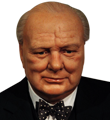Winston Churchill Death
|
| updated |
Copy Link Code
|
 For Winston Churchill, death would not easily overtake him. In fairly good health most of his life – despite some minor setbacks here and there – the death of Winston Churchill was a slow decline.
For Winston Churchill, death would not easily overtake him. In fairly good health most of his life – despite some minor setbacks here and there – the death of Winston Churchill was a slow decline.
In the years before Winston Churchill died, he had been in a slow decline, health-wise. Some even thought he might have Alzheimer's disease, but that has never been confirmed. Others said that his diminishing mental health was a direct result of several strokes. Whatever the reason, when he was named an Honorary Citizen of the United States by President John F. Kennedy (in 1963), Churchill was unable to attend the ceremony at the White House, because of his failing health.
On January 15, 1965, Churchill suffered another stroke. This catastrophic stroke, especially at his age (90 years old) left him gravely ill. He uttered his last words, "I'm bored with it all" and slipped into a coma. Nine days later, Winston Churchill – great leader, statesman, military man, father, and husband – died in his London home (Chartwell) the morning of Sunday, January 24, 1965, which was exactly 70 years to the day following his father's death.
Six days later, the funeral of Winston Churchill – the largest state funeral in the history of the world (at that point) – commenced in Britain. There were representatives from 112 nations (only excluding China). The televised broadcast of Winston Churchill's funeral was broadcast live by every European country (except Ireland), with 350 million people watching – 25 million in Britain, alone. According to the Queen's decree, his body was ordered to 'lay in state' (on public display so people can pay their respects) for three days. Held at St. Paul's Cathedral, the service for his funeral was one of the largest assemblages of statesmen in the entire world, up to that day. Although it was unusual, the Queen actually attended the funeral in person. As the procession passed by the River Thames, dockers 'saluted' by lowering their crane jibs. The Royal Artillery fired a 19-gun salute, and the Royal Air Force (RAF) had a fly-by of 16 English Electric Lightning fighters. The coffin was then loaded onto a train, for its trip to Handborough.
While the funereal train passed, thousands of British citizens silently stood by, paying their last respects. Finally, Winston Churchill was buried in a grave in his family plot at St. Martin's Church, Bladon, close to Woodstock. Ironically, the location of the Winston Churchill grave is not very far from the place of his birth (Blenheim Palace). In September 1965, an engraved green marble memorial to Churchill – cut by Reynolds Stone (an engraver) – was placed in Westminster Abbey, just inside the west entrance. The memorial states:
"REMEMBER
WINSTON
CHURCHILL
IN ACCORDANCE WITH THE WISHES OF
THE QUEEN AND PARLIAMENT
THE DEAN & CHAPTER PLACED THIS STONE
ON THE TWENTY FIFTH ANNIVERSARY OF
THE BATTLE OF BRITAIN
15 SEPTEMBER 1965"
